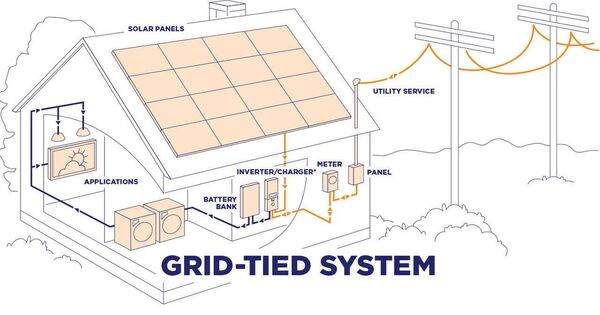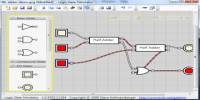A grid-tied electrical system, also known as a tied-to-grid or grid-tie system, is a semi-autonomous electrical generation or grid energy storage system that connects to the mains and feeds excess capacity back into the local electrical grid. It is a renewable energy system that works in combination with the utility grid. When there is insufficient electricity available, electricity obtained from the mains grid might make up the difference.
Renewable energy sources, such as solar panels or wind turbines, are connected to the utility grid via an inverter in this arrangement. When excess electricity is available, it is routed to the main grid. When a utility or network operator limits the quantity of energy that enters the grid, it is feasible to block any input by installing Export Limiting devices. When batteries are utilized for energy storage, the system is known as battery-to-grid (B2G), which also includes vehicle-to-grid (V2G).
How it works
Direct Current (DC) electricity from hydro, wind, or solar is sent to a grid-connected inverter. The inverter detects the alternating current mains supply frequency and generates power that is phase matched to it. Most inverters can continue to offer courtesy electricity when the grid refuses to accept power during a “black out”.
- Energy Production: Renewable energy sources, such as solar panels or wind turbines, generate electricity when sunlight or wind is available.
- Inverter Conversion: The electricity generated by the renewable energy source is in direct current (DC) form. The inverter converts this DC electricity into alternating current (AC), which is compatible with the grid and most household appliances.
- Grid Connection: The AC electricity produced by the inverter is then fed into the electrical grid. It is indistinguishable from the electricity generated by conventional power plants.
- Usage and Net Metering: If the renewable energy system generates more electricity than is consumed on-site, the excess power is fed back into the grid. In contrast, when demand exceeds on-site generation, electricity is pulled from the grid. This bidirectional flow of electricity is frequently aided by a utility meter that can monitor both import and export of electricity, also known as net metering.
- Energy Billing: In many jurisdictions, households and businesses using grid-tied systems earn credits for excess electricity generated, which can be used to offset their electricity bills. This is frequently accomplished through net metering agreements or feed-in tariffs.
Benefits of grid-tied electrical systems include:
- Reduced Electricity Bills: By generating electricity on-site, consumers can reduce their reliance on grid electricity and potentially lower their electricity bills, especially with favorable net metering policies.
- Environmental Benefits: Utilizing renewable energy sources reduces the consumption of fossil fuels and greenhouse gas emissions associated with electricity generation.
- Grid Stability: Grid-tied systems can contribute to grid stability by providing additional sources of electricity during peak demand periods or in areas with unreliable grid infrastructure.
- Financial Incentives: Many governments offer incentives, such as tax credits or rebates, to encourage the installation of grid-tied renewable energy systems.
However, grid-tied systems may have limitations, particularly during grid outages. Most grid-tied systems are designed to automatically shut down during power outages to prevent backfeeding electricity into the grid, which could pose a safety hazard to utility workers attempting to repair the grid. To provide backup power during outages, additional equipment such as battery storage systems or backup generators may be required.
















